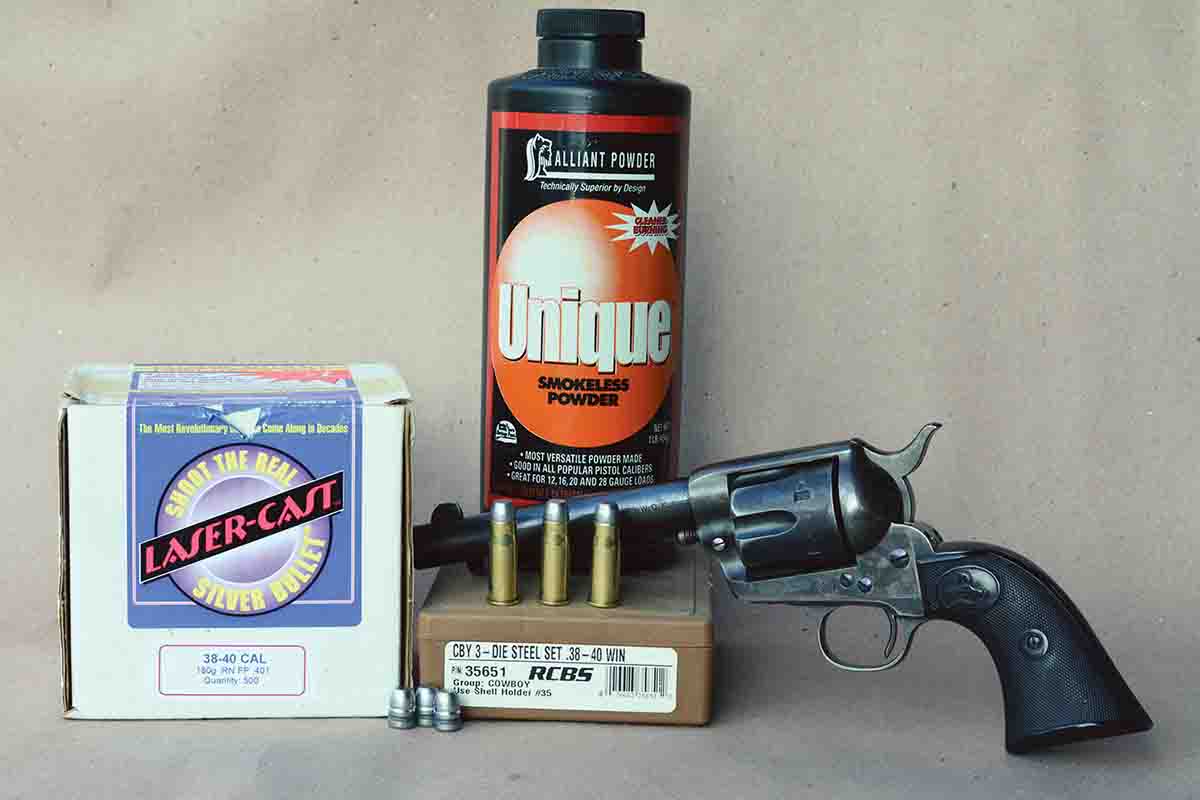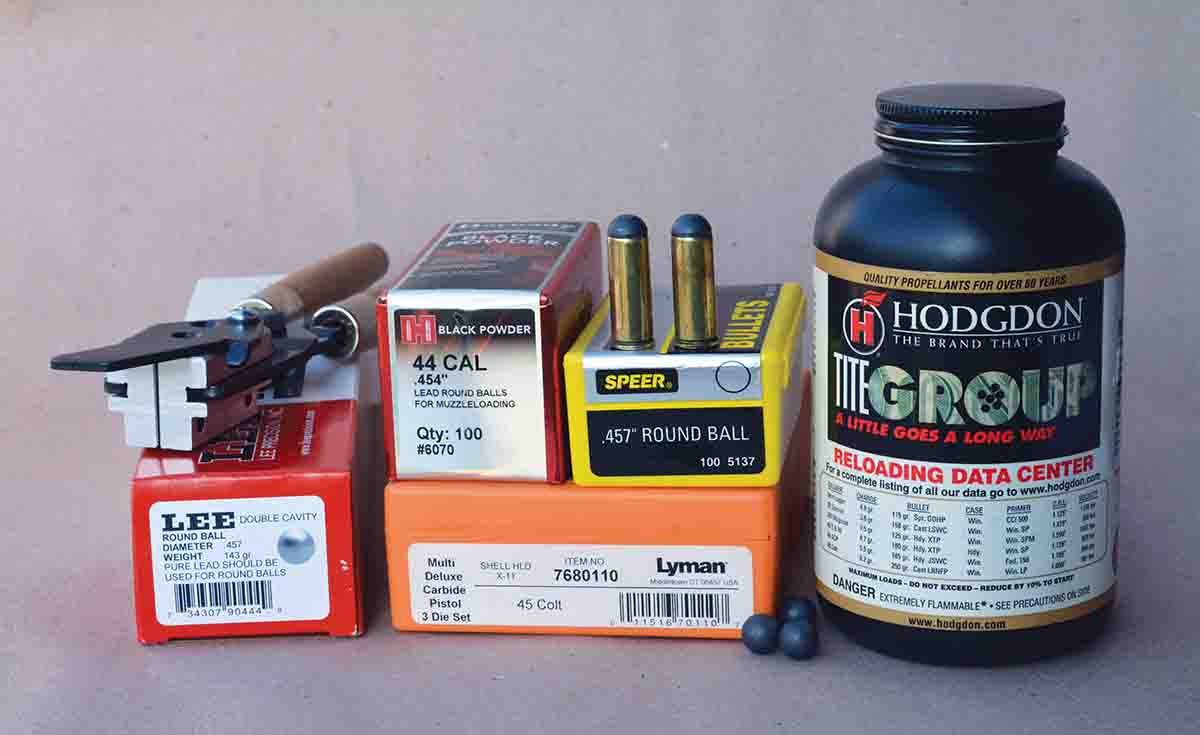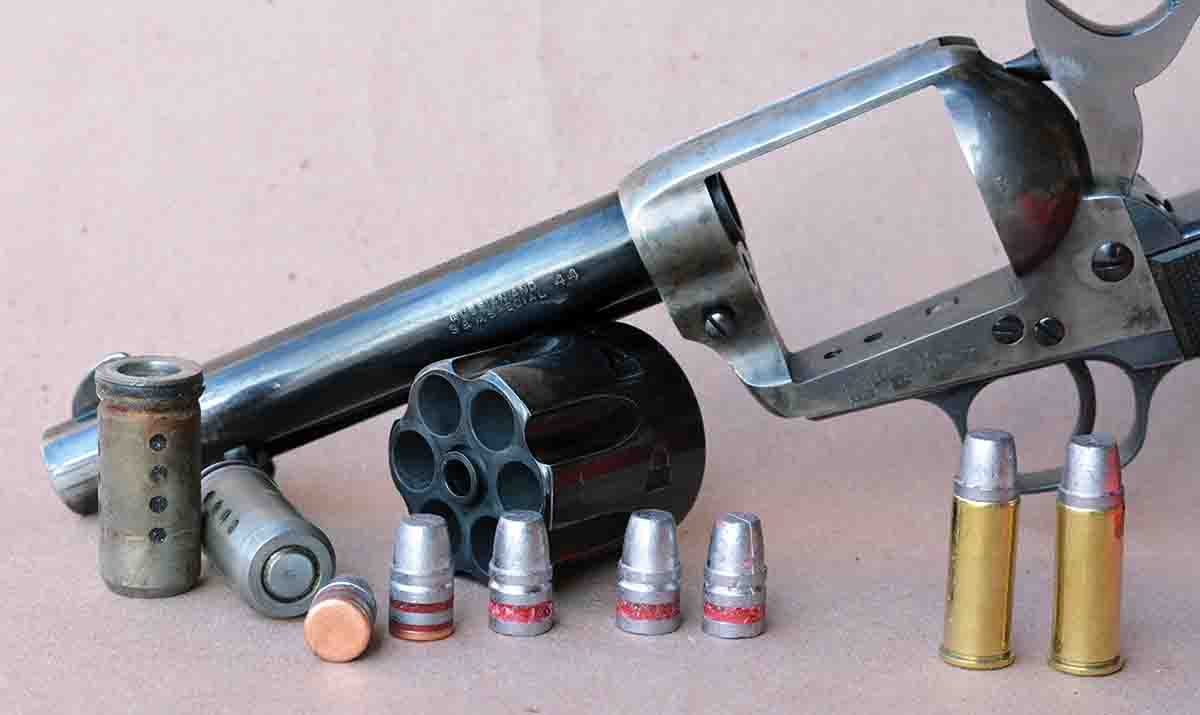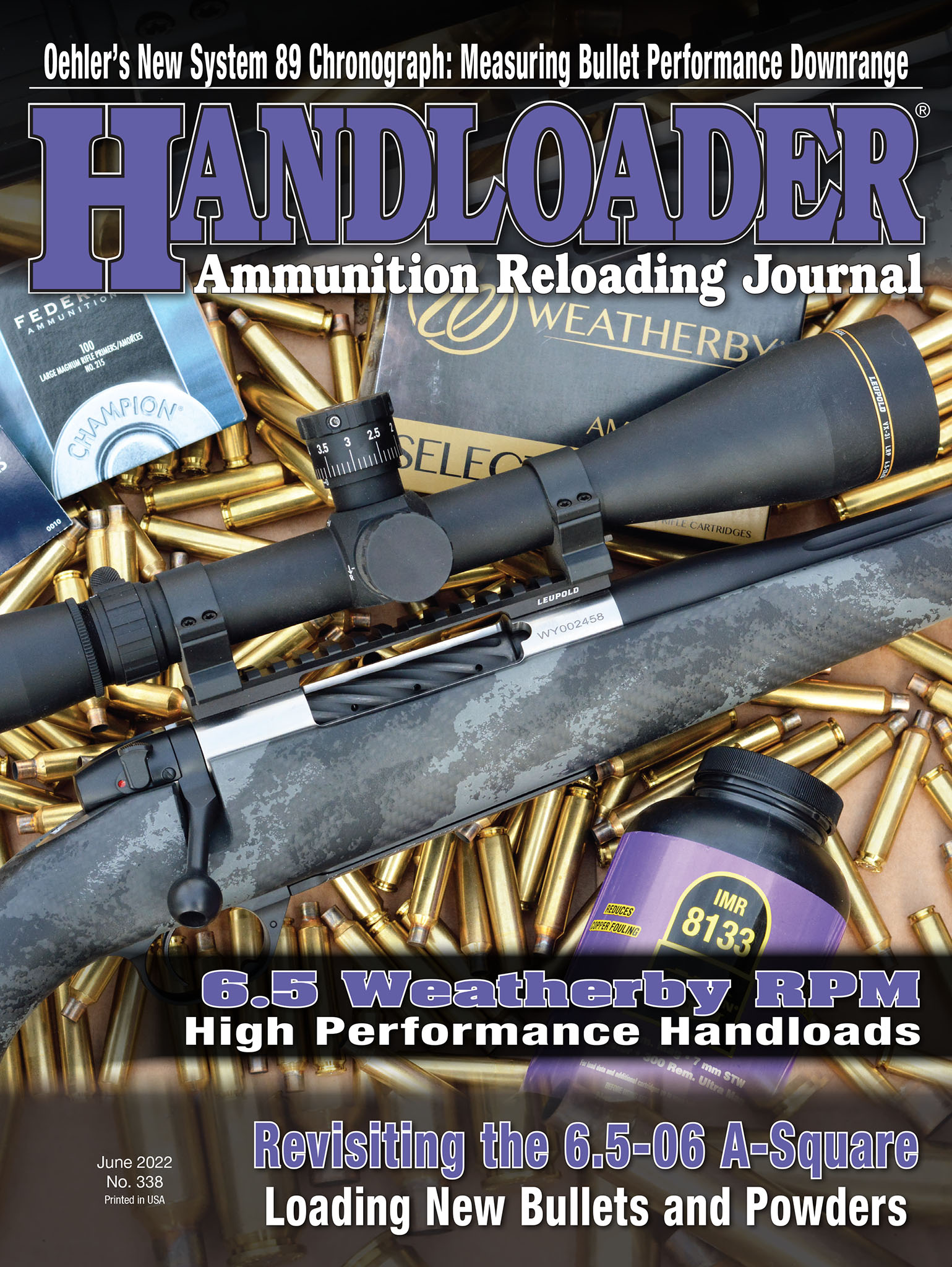Bullets & Brass
The Problem with Low Pressure Loads
column By: Brian Pearce | June, 22

Here are my bad experiences. Back in the early 1960s, I purchased a very nice pre-World War II Colt Single Action Army chambered in .38-40 Winchester with a 5½-inch barrel. The second generation guns were in production, but they were hard to find and were bringing at least $125. I felt like I got a bargain when I paid $80 for the gun and three boxes of Western 180-grain jacketed SP ammunition. I shot two boxes up and my dad coached me on how to reload those 100 empty cases. The local hardware store stocked handloading components and a quantity of .38-40 180-grain JSP bullets (I think they were Remington) were obtained. We used 9 to 9.5 grains of Hercules Unique with the factory bullets, which worked perfectly and seemed more consistent than the factory loads.
When I moved on to college, a friend had a C-H reloading press, so I ordered dies and purchased IMR SR4756 powder. The suggested data was from a reputable reloading manual. I loaded 8 grains, seated bullets and headed to a shooting area with my roommate. I fired a few rounds and realized that these loads were seriously low on velocity. But I knew there was a real problem when I held the Colt at my side, with the muzzle pointing downward, then raised the muzzle level and fired at a target. The cartridge made a swishing noise and the bullet didn’t fly, rather it stuck firmly in the bore. We went back to town and tapped the bullet out with a steel rod. I thought I had put in the wrong powder charge. But I pulled a few bullets and the charge was correct. I repeated the above and bullets either stuck in the bore again or they barely made it out of the barrel. But when the muzzle was pointed up, then lowered on target, the loads worked fine although they still were slower than my original load using Unique powder.
Fast forward 30 years, after a military career, I had time to begin handloading again. I had a very similar occurrence with .38 Special loads that contained 125-grain Hornady XTP bullets with ball powder. My selected powder charge and load was listed as “standard pressure” and has been published in several sources. But again, when the powder was positioned either level in the case, or to the rear of the case, the load worked fine, but when the powder was resting on the base of the bullet, it would often squib. Either the bullet would stick in the bore, or barely have enough velocity to exit. This was discouraging to say the least. I contacted the manufacturer of the powder and received no response. Can you suggest a good +P load that will not have this issue?
Obviously, this problem has been an issue with some handloading data, but also factory loads. I am hoping you can shed some light on this subject. I greatly appreciate your insight into handloading.
J.T.H., Cascade, ID
A: Unfortunately the problem of sticking bullets in the bore has been somewhat common with certain cartridges, especially those that are low pressure and have a comparatively large case capacity (from the black powder era) such as the .45 Colt, .44-40, .38-40, .32-20, etc. However, it is preventable, especially once we understand the combinations that cause this to occur. In the case of the .32-20 factory loads that you mention, this was a combination of problems.
First, jacketed bullets require notably greater pressure to be pushed down the barrel. When loads exhibit too little pressure, the bullet can stick in the bore. The reason that cartridges were firing normally with the powder positioned to the rear (or with muzzle up) was that pressure and velocities were higher, but when the powder was positioned forward, resting on the base of the bullet, pressures dropped and there was not enough energy to push the bullet down the barrel. The .32-20 is a low-pressure cartridge (SAAMI lists it at 16,000 CUP maximum). Many faster burning powders that are commonly used in factory loads only, use a small portion of the case capacity, so it becomes important to select a powder that is not position sensitive. I do not know what powder the factory was using in this instance, but it was clearly position sensitive. Some modern powders show very little change in pressure and velocities when positioned forward or back, and should be top choices when handloading low pressure cartridges with comparatively large capacities. In offering considerable handloading data for Wolfe Publishing, you will often see me reference powders that are not position sensitive.
Regarding your .38-40 W.C.F. handloads; they were clearly suffering from the very same problem of the referenced .32-20 factory loads. In other words, your powder choice was position sensitive and there was just not enough pressure to reliably push the jacketed bullets out the bore. Increasing the charge weight of IMR SR4756 powder to 9 or 9.5 grains would have solved your problem, but that powder is now discontinued.
Generally speaking, I see more serious problems with handloads and handload data that is too light, rather than excessive. This is when we see bullets stuck in the bore, hangfires, etc. If a bullet sticks in the bore and the gun is fired without removing it, there is certain to be damage to the barrel, or worse.
The .38 Special handload data that you mention is famous for the very problem you describe (with those loads removed from this column for that reason). Ball or spherical powders are not all equal, and in your case, that powder needed more pressure for reliability. This is important, but the reason that this .38 Special load data was so widely published was that the ballisticians that developed this load were in a lab, using a fixed test barrel. In other words, there was no barrel cylinder gap that is common with revolvers. When the cartridge is fired in a revolver and the bullet passes the barrel-cylinder gap, the pressures drop instantly low. Regarding your handloads, due to the position sensitive nature of this powder and the drop in pressure when fired in a revolver, bullets will stick in the bore.
As per your request for a reliable +P .38 Special load, using Hornady’s 125-grain XTP bullet, try 7 grains of Alliant Power Pistol powder for 1,078 fps, or 7.3 grains of Hodgdon Longshot for 1,072 fps from a 6-inch barrel.
Roundball Loads

I would like to give roundball loads another try, but in referencing all current manuals, there is no longer any data. Perhaps you could offer handload recipes that will give better results? I would still like to reach around 550 fps if possible. Any insight will be greatly appreciated.
J.G., email
A: There are several factors as to why your roundball handloads were not working well. You don’t state any particulars about your gun, but there is a good chance that the throats are .456 to .457 inch. When cartridges are fired using the .454-inch, 141-grain bullets, there is very little resistance as the bullet passes through the throats, which results in too little pressure for reliable ignition with SR4756 powder.
I suggest changing components. First, by using a .457-inch roundball bullet, this will help increase bullet pull in the case and should help generate a bit more resistance as the bullet passes through the throats. If your gun has tighter throats (.451 to .452 inch), .454-inch bullets will be preferred. Hornady and Speer both offer .454- and .457-inch bullets as a component, while Lee offers a bullet mould in either diameter. Several powders will work, but Hodgdon Titegroup is a top choice, as it ignites easily and is one of the least position sensitive pistol powders. Nonetheless, with such a low-pressure cartridge, there will be velocity swings depending on powder positioning. To help minimize this issue, I recommend using a large pistol magnum primer such as the Federal 155 or CCI 350, which will help get instant and reliable powder ignition and prevent the “large muzzle flame” that you described. Seat bullets so that the case can be heavily roll crimped just over center for an overall cartridge length of 1.510 inches. This heavy crimp is important to further obtain proper ignition.
Try 4.8 grains of Titegroup for an average velocity of 550 fps. With the powder positioned on the base of the bullet, velocity will be around 500 fps, but with the powder resting at the rear of the case, velocity will be around 600 fps. For the best accuracy, position the powder to the rear of the case for each shot.
Groove Diameter

J.J., Billings, MT
A: Using .430- to .431-inch bullets in a revolver with .431-inch throats and a .427-inch groove diameter will not increase pressure. Modern piezoelectric pressure testing methods clearly establish that peak pressures occur before the bullet exits the case, and by the time it engages the rifling, pressures have dropped significantly. So the bullet being sized down as it enters and travels down the barrel will have no practical effect on pressure.
Ammunition factories have often used hollowbase lead bullets (including in the .44 Special) to help them obturate in the throats, seal off the gases, prevent leading and keep the bullet straight as it enters the barrel, all of which helps accuracy as opposed to a soft lead bullet with a plain base. Bullets can also be cast soft enough that they will obturate (with enough pressure) to seal off gases, but the bullet becomes somewhat deformed in this process, which can leave accuracy potential on the table, so to speak. Also, due to the soft construction, the above bullets can cause leading, especially if velocities exceed 850 to 900 fps. Accuracy can be pretty good in some guns; however, using better bullets will further improve accuracy.
Tests have proven that by using cast bullets, preferably with an appropriate alloy for a given velocity and that are sized to match, or are slightly larger than throat diameter, there will be less blowby (which can result in fusion and barrel leading), less bullet deformation and neither will the bullet tilt as it passes through the throat. This will help the bullet enter the barrel straight and overall increases accuracy potential.
Just for the record, I was fortunate to have known Elmer Keith. I had great admiration for him, his opinion and his pioneering of modern sixguns and cartridges.


